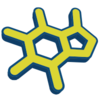 | |
| Content | |
|---|---|
| Description | Chemical database |
| Data types captured | Small chemical compounds |
| Contact | |
| Research center | European Molecular Biology Laboratory |
| Laboratory | European Bioinformatics Institute |
| Primary citation | de Matos et al[1] |
| Access | |
| Website | www |
| Download URL | ftp |
| Web service URL | www |
| Sparql endpoint | BIO2RDF |
| Tools | |
| Web | www |
| Miscellaneous | |
| Data release frequency | monthly |
| Curation policy | Manually curated |
Chemical Entities of Biological Interest, also known as ChEBI,[1][2] is a chemical database and ontology of molecular entities focused on 'small' chemical compounds, that is part of the Open Biomedical Ontologies (OBO) effort at the European Bioinformatics Institute (EBI). The term "molecular entity" refers to any "constitutionally or isotopically distinct atom, molecule, ion, ion pair, radical, radical ion, complex, conformer, etc., identifiable as a separately distinguishable entity".[3] The molecular entities in question are either products of nature or synthetic products which have potential bioactivity. Molecules directly encoded by the genome, such as nucleic acids, proteins and peptides derived from proteins by proteolytic cleavage, are not as a rule included in ChEBI.
ChEBI uses nomenclature, symbolism and terminology endorsed by the International Union of Pure and Applied Chemistry (IUPAC) and nomenclature committee of the International Union of Biochemistry and Molecular Biology (NC-IUBMB).
YouTube Encyclopedic
-
1/3Views:10 5261 4047 191
-
7 ПРОДУКТОВ ОТ ЦЕЛЛЮЛИТА. СПИСОК САМЫХ ПОЛЕЗНЫХ ДЛЯ ОРГАНИЗМА.
-
The Role of Flash Chromatography in Natural Product Research
-
Tutorial: Introduction to Basic Formal Ontology 2.0 (2015)
Transcription
Scope and access
All data in the database is non-proprietary or is derived from a non-proprietary source. It is thus freely accessible and available to anyone. In addition, each data item is fully traceable and explicitly referenced to the original source. It is related in scope other databases such as ChEMBL, ChemSpider, DrugBank, MetaboLights and PubChem.
ChEBI data is available through a public web application, web services, SPARQL endpoint and downloads.[1][2]
References
- ^ a b c de Matos P, Alcántara R, Dekker A, Ennis M, Hastings J, Haug K, Spiteri I, Turner S, Steinbeck C (2010). "Chemical Entities of Biological Interest: an update". Nucleic Acids Research. 38 (Database issue): D249-54. doi:10.1093/nar/gkp886. PMC 2808869. PMID 19854951.
- ^ a b Degtyarenko K, de Matos P, Ennis M, Hastings J, Zbinden M, McNaught A, Alcántara R, Darsow M, Guedj M, Ashburner M (2008). "ChEBI: a database and ontology for chemical entities of biological interest". Nucleic Acids Research. 36 (Database issue): D344-50. doi:10.1093/nar/gkm791. PMC 2238832. PMID 17932057.
- ^ IUPAC, Compendium of Chemical Terminology, 2nd ed. (the "Gold Book") (1997). Online corrected version: (2006–) "molecular entity". doi:10.1351/goldbook.M03986
 ChEBI ID (P683) (see uses)
ChEBI ID (P683) (see uses)
